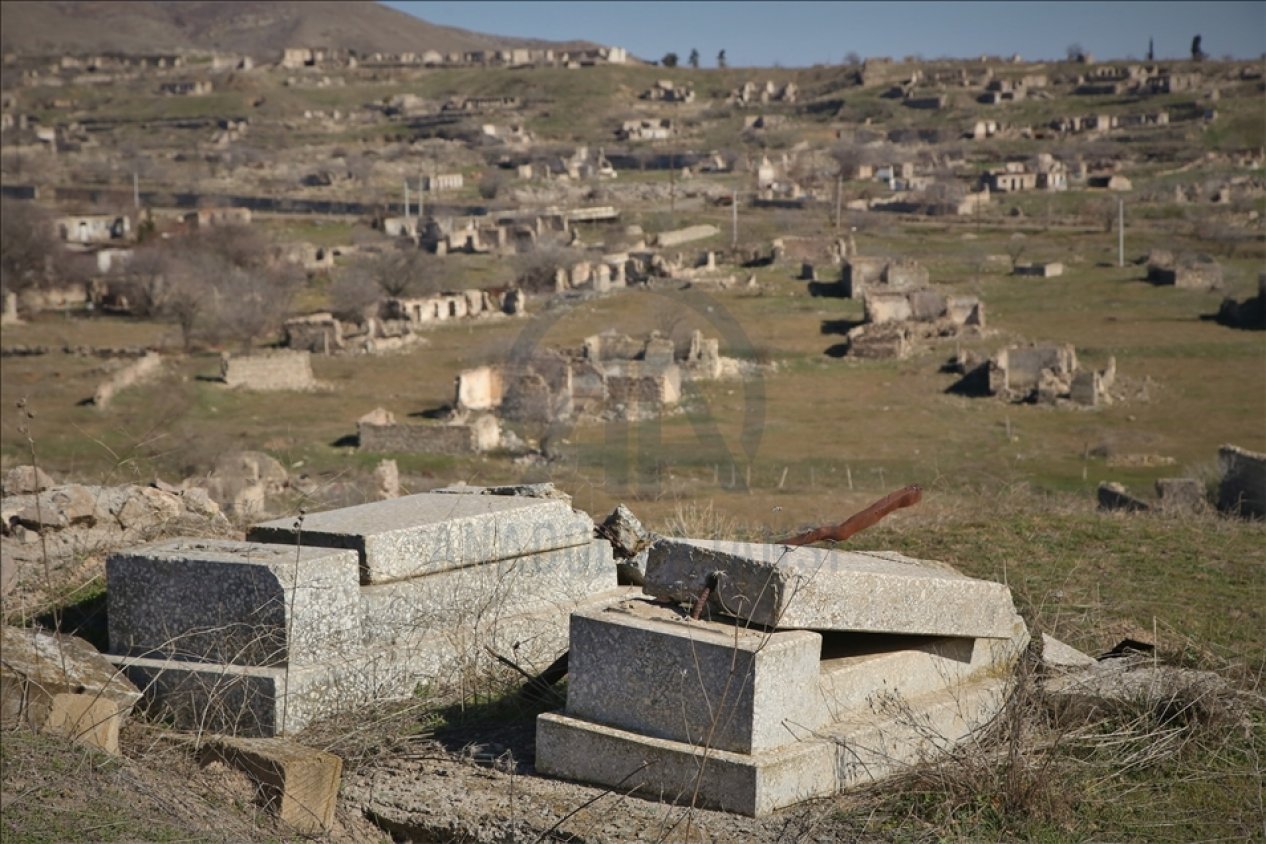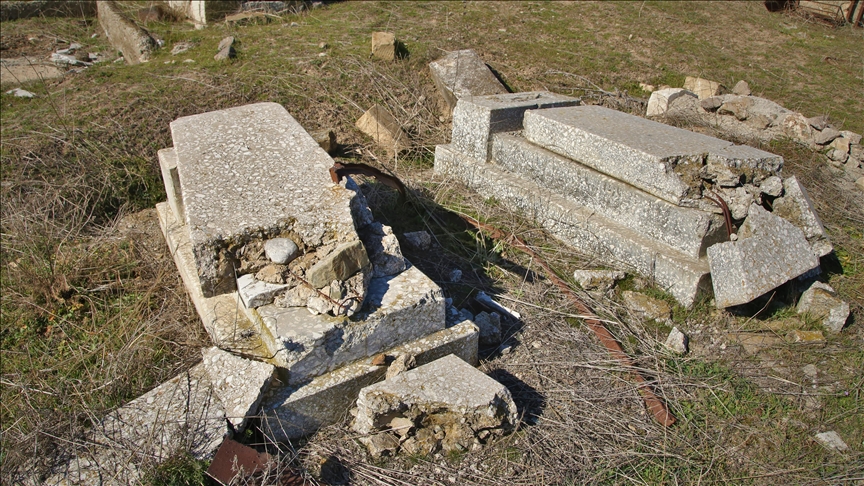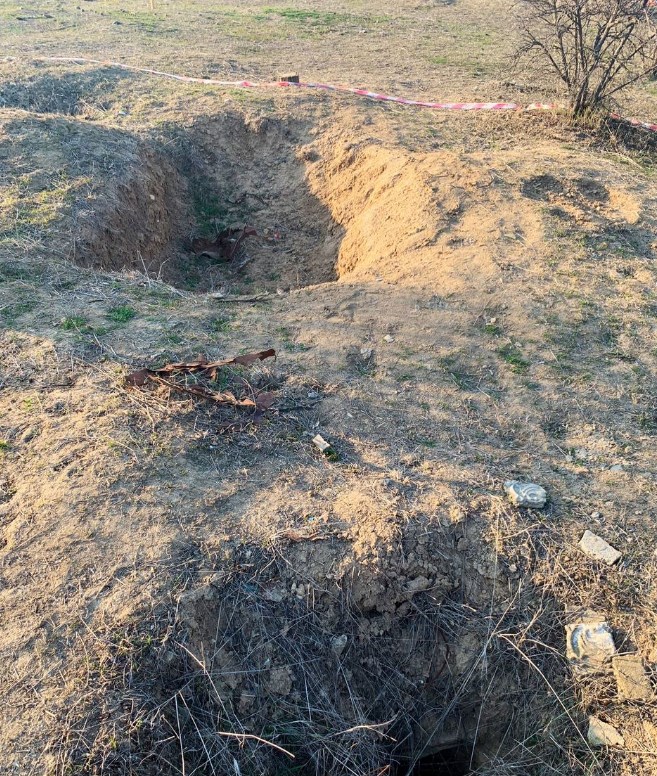
The desecration of graves and the destruction of cultural monuments are part of "Turkish identity." "The destruction of cultural monuments, temples, attempts to erase any historical trace, to destroy the cultural heritage of the peoples whose territories they occupy, are accompanied by attempts to give their barbarism a shade of religious struggle, presenting themselves as defenders of Islam and all Muslims of the world," the Armenian Infoteka24 website wrote.
For example, the publication cited a video shared on social networks during the Second Karabakh war, where an Azerbaijani soldier kicks the tombstone of an Armenian occupier buried in Karabakh.
The main proof of the falsity of the Armenian publication's statements is the fact that in Azerbaijan, unlike Armenia, persons who commit such misconduct are subject to criminal prosecution, regardless of whether they were committed during the hostilities or in peacetime.
The General Prosecutor's Office and the Military Prosecutor's Office of Azerbaijan analyzed videos of Azerbaijani servicemen insulting the bodies of Armenian soldiers killed during the war and the inhuman treatment of captured Armenian servicemen, published by social media pages. Even though many of them were found to be fabricated, some are believed to be authentic.
Based on the materials collected in connection with the above reports, the Military Prosecutor's Office initiated a criminal case under Articles 115.2 (torture, inhuman treatment) and 245 (desecration of a grave or a corpse) of the Criminal Code of the Republic of Azerbaijan. The necessary operational and investigative measures are currently being taken.
During the investigation, reasonable suspicions arose that Rashad Aliyev and Gardashkhan Abishov, who served as junior warrant officers in a military unit of the Armed Forces of the Republic of Azerbaijan, insulted the bodies of Armenian servicemen who died during the hostilities in the Zangilan district, filmed their actions using a smartphone and distributed the footage via social networks.
The investigation also established suspicions that Azerbaijani servicemen Arzu Huseynov and Umid Aghayev destroyed tombstones belonging to Armenians at the cemetery in the Madatli village of Khojavand district, filmed their actions using a smartphone and distributed the footage via social networks.
Rashad Aliyev, Gardashkhan Abishov, Arzu Huseynov, and Umid Aghayev were held as suspects in committing crimes following the relevant articles of the Criminal Code and arrested by a court decision.
Other similar videos distributed on social media are being investigated, and detailed information will be provided to the public about the results.
The General Prosecutor's Office of the Republic of Azerbaijan declares that the aforementioned criminal acts committed by the Azerbaijani military personnel are unacceptable and contradict the mentality of the Azerbaijani people, which is historically humane and tolerant, and keeps multicultural values. Persons who have committed similar offenses will be prosecuted under the law.
The report of the Prosecutor General's Office demonstrates the attitude of the Azerbaijani state to such facts. Meanwhile, in Armenia, for 30 years of occupation of Azerbaijani territories, there was not a single fact of punishment for such actions, which were perpetrated on a mass scale.
Over the decades of occupation of Nagorno-Karabakh and seven adjacent districts of Azerbaijan, the Armenian Armed Forces destroyed not only settlements but also the Azerbaijani cemeteries. The complete picture of destruction and vandalism became apparent only after the liberation of the historical lands of Azerbaijan from occupation.
The settlements in the liberated Fuzuli, Jabrayil, Zangilan, Gubadli and Aghdam districts of Azerbaijan were destroyed entirely. The cemeteries in these areas suffered the same fate. The Armenians desecrated the gravestones and took some of them to Armenia.
The Azerbaijanis, who returned to their native lands, visited the graves of their relatives and friends. Most of the gravestones had not survived, though.
The city cemetery of Jabrayil was one of those destroyed by the Armenians. Not a single grave remained intact there. You can also find open graves with human remains at the Jabrayil cemetery.

Armenian vandals were never ashamed of their actions, knowing that nothing threatened them in Armenia. In the years of the occupation, they boldly posted photos and videos on social networks. For example, this photo in the Armenian Facebook segment was taken at a cemetery destroyed by the Armenians in occupied Aghdam. A man in military uniform trousers and slippers demonstrates the exceptional "values" and "civilizational role" of the Armenian invaders, desecrating the Azerbaijani graves. Judging by the photo, the man is very proud of his antics and feels almost like a hero, posing in indecent poses near the tombstones and stamping his feet on the grave.

Several years ago, a video of the destruction of the national hero of Azerbaijan Allahverdi Baghirov's gravestone went viral on social networks.
Vandals, on the initiative of Arshak Zakaryan, who threatened to "reach Baku," smashed the tombstone with a sledgehammer.
Baghirov was buried in the Martyrs' Alley in Aghdam. The invaders dismantled the tombstone, took it to Khankendi, and destroyed it in the city center.
A video of the act with Zakaryan's offscreen comments appeared on the web. Both he and his fellow vandals were especially outraged because the monument to the hero was erected by the Armenians, who had been friends with Baghirov since childhood.
In his reports, UN Special Representative Staffan de Mistura pointed out that during the First Karabakh War, Allahverdi Baghirov did more to save the Armenian prisoners and Khojaly residents than all international organizations put together. It is evident that in this way, the Armenians "thanked" Allahverdi Baghirov for the civilians of the Armenian nationality he saved.
After the occupation of Aghdam by the Armenians, all the cemeteries there were vandalized. Still, the grave of Allahverdi Baghirov was preserved by his childhood friend Razmik Petrosyan, who previously lived in Ganja. The tombstone was smashed with a sledgehammer in front of hundreds of residents in Khankendi's central square.
The Russian military expert, editor-in-chief of the Natsionalnaya Oborona magazine Igor Korotchenko reported that before leaving the Aghdam district (as envisaged by the Trilateral Statement of the leaders of the Russian Federation, Azerbaijan, and Armenia), Armenian servicemen opened graves and threw away the remains of long-dead people, demonstrating hatred to the Azerbaijanis.

Azerbaijani cemeteries in Armenia were subjected to total desecration.
Destroyed cemetery in Fuzuli.
One of the most terrible facts of Armenian barbarism is the desecration of the Azerbaijani poetess Natavan's grave.
Well-known photographer Reza Deghati shared a photo and video footage of the monument to Azerbaijani poetess Khurshidbanu Natavan in Aghdam, destroyed by Armenian vandals. The photographer was outraged by the fact that the Armenians not only destroyed her grave but also removed the remains.
According to the photographer, in 1992, before the occupation of the city by the Armed Forces of Armenia, he visited the mausoleum of the poetess and was amazed at the architecture, as well as the beauty of her monument:
"After the liberation of the city in November 2020, I visited this place again. Everything was destroyed. But that was not the worst thing. The horror is that her grave was plundered, and even the remains of Khurshidbanu Natavan were taken away. Perhaps these were the people who at one time drank water from the aqueduct built with her money," Reza Deghati wrote on Instagram.
Recently, footage testifying to the inhumanity of the Armenian invaders was shared on Telegram.
A man 28 years ago buried his 8-year-old son in a village of the Aghdam district. The child had died during the seizure of the village by Armenians. Returning 28 years later, he found the grave, but it turned out that the Armenians did not leave the child alone even after death, having treated his remains outrageously.
The fact that desecration of graves and mockery of the dead are a feature of Armenian identity can be judged by the fact that similar actions are carried out against their own fellow citizens in Armenia. Several years ago, the graves of Armenian soldiers killed during the April 2016 battles were desecrated. ARF-D member Artur Yeghiazaryan wrote on his Facebook page.
He also posted video footage.
The recording shows liquid spilled on the graves, possibly candle wax. Artur Yeghiazaryan noted: "A video has been circulating on Facebook, which shows how the 'inner Turks' desecrated the graves. I demand explanations from the competent authorities regarding the protection of the Yerablur Pantheon and the identification of villains."
Vandalism against cemeteries and the dead has always been a hallmark of Armenian nationalists. It is evidenced by both the massiveness of such crimes on the part of the Armenians, and the impunity of their perpetrators in the country. In contrast, in Azerbaijan, such cases are isolated and are subject to criminal prosecution.




















